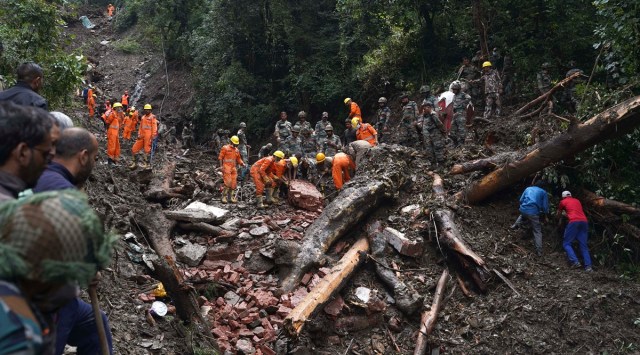Landslides in hill states: NDMA’s 2019 report flagged poor planning, lax laws, tourism pressure
Document states building plans of hill states are mostly copied from Delhi master plans, which are inappropriate for the region
 Rescuers search the debris for survivors after a landslide following heavy rainfall in Shimla, Himachal Pradesh. (Photo: AP)
Rescuers search the debris for survivors after a landslide following heavy rainfall in Shimla, Himachal Pradesh. (Photo: AP) AS HEAVY rain and landslides continue to ravage hill states in the country, a 2019 strategy document published by the National Disaster Management Authority (NDMA) shows that concerns related to poor urban planning, lack of comprehensive land use policy, lax enforcement of construction laws and excessive tourism in these regions had been flagged then too. The document pointed out how building plans of hill states were copied from the Delhi Master Plan.
“The widespread property loss during recent landslides and related hazards like cloudburst and flash floods have shown that most of the construction plans are ill-conceived and do not follow standard norms. The design codes are generally not followed even by the government departments. This has created an alarming situation where a large number of unsafe building stock is added each year to the already huge number of existing unsafe buildings in hostile climate, fragile environment and tectonically active unstable hilly terrain,” the document said.
The document, National Landslide Risk Management Strategy, is a result of three years of research, field visits and consultation with stakeholders by a task force of experts constituted by NDMA in 2016.
In its report published in September 2019, the NDMA stated that there was “no land use policy in the country at national, state and local level for implementation”.
“The cities of the Himalayas are growing and beginning to turn into mountains of garbage and plastic, untreated sewage, chronic water shortages, unplanned urban growth and even local air pollution because of vehicles. These towns need to be planned, particularly keeping in mind the rush of summer tourists. Many states have experimented from banning plastics to taxing tourists to better respond to these issues. But they need support and new thinking,” the document said.
 As per the latest figures from the Chief Minister’s office, the death toll in the heavy rain and landslides climbed to 60 in the state. (PTI)
As per the latest figures from the Chief Minister’s office, the death toll in the heavy rain and landslides climbed to 60 in the state. (PTI)
The document highlighted problems related to planning and design of buildings, inadequate infrastructure, improper housing/building stock having insufficient strength, unprecedented cutting of vegetation and slopes etc. in hill towns. It flagged how building regulations were copied from the Delhi Master Plan.
“Most of these issues/problems are due to inappropriate planning proposals and building regulations enforced in different hill towns. Existing building regulations enforced in Indian hill towns are mostly inspired from Delhi Master Plan(s), which are not appropriate to the context of hill towns, as the geo-environmental and socio-developmental context of Delhi is varied to a greater extent from that of hill towns,” the document said.
 A view shows debris after a landslide following torrential rain in Mandi in Himachal Pradesh. (Reuters)
A view shows debris after a landslide following torrential rain in Mandi in Himachal Pradesh. (Reuters)
According to the document, while municipal bylaws must provide for construction activity to be regulated in areas which fall in hazard zones, in many cases these provisions have not been strictly enforced. It said the State Municipal Acts in all the Indian Himalayan Region (IHR) and Western Ghats (WG) states are more focused on other issues than landslide problems.
Some of these concerns, more specific to Shimla, were also flagged in a 2022 compendium of landslides published by NDMA.
Flagging how deforestation, road cutting, terracing and changes in agriculture crops requiring more intense watering had disturbed the equilibrium of the hills, the compendium had said, “The town (Shimla), which was built for a population of just 25,000 in the early 20 century, today houses close to 3,00,000 people. And, as against the recommended density of 450 persons per square hectare in hill settlements, the town’s localities have densities ranging from 2,500 to 3,500 persons for the same area.”
Underlining that most of the town was built on slopes between 45 and 75 degrees, the compendium said, “Some 90% of central Shimla, built on a 60 degrees slope, is covered with buildings which are four to five stories high. In the event of an earth tremor, the devastation could be enormous, with buildings on slopes steeper than 45 degrees collapsing in a chain.”
 Underlining that most of the town was built on slopes between 45 and 75 degrees, the compendium said, “Some 90% of central Shimla, built on a 60 degrees slope, is covered with buildings which are four to five stories high. In the event of an earth tremor, the devastation could be enormous, with buildings on slopes steeper than 45 degrees collapsing in a chain.”
Underlining that most of the town was built on slopes between 45 and 75 degrees, the compendium said, “Some 90% of central Shimla, built on a 60 degrees slope, is covered with buildings which are four to five stories high. In the event of an earth tremor, the devastation could be enormous, with buildings on slopes steeper than 45 degrees collapsing in a chain.”
The report said cutting costs was among the reasons for vulnerable buildings. “In the hills, it’s imperative to build on pillars that rest on rock strata. People raise pillars for buildings which are embedded in loose soil because the cost of construction goes up substantially if deeper pillars are to be made.”
The 2019 report had made certain recommendations with regard to such vulnerabilities. “Where cutting of hill slope in an area causes ecological damage and slope instability in adjacent areas, such cuttings shall not be undertaken unless appropriate measures are taken. No construction should be ordinarily undertaken in areas having slopes above 30 degrees or areas which fall in landslide hazard zones or areas falling on the spring lines and first order streams.”
The report also emphasised the necessity of load bearing tests, hazard zonation and slope and land-use maps to guide urban planners for clearing constructions.
It also flagged paucity of basic data (e.g., rainfall) in mountainous areas, especially in the Northeast.
It said there was a need for a national strategy to focus on implementation and enforcement of laws/regulations and accountability.
On mitigation of landslides, the 2019 report underlined that no Union ministry had any scheme for landslide risk management in the country.
“It is noticed that due to resource crunch, most of the States, particularly Hilly States, are unable to take up mitigation, rehabilitation and reconstruction measures,” it said.
On frequent destruction of infrastructure due to landslides, the report said, “The present engineering practice relies on fragmentary approaches involving quick-fix treatments of landslides, which end up in their recurrence year after year at the very same locations. Paucity of funds, absence of delivery capacity and urgency to deal with immediate landslide danger are generally cited as reasons for this continuing practice.”
“The permanent solutions to our major landslide problems may appear at the face value to be capital intensive and even unaffordable, but in the true analysis, the benefits of permanently fixing landslides will far overweigh,” it said.







